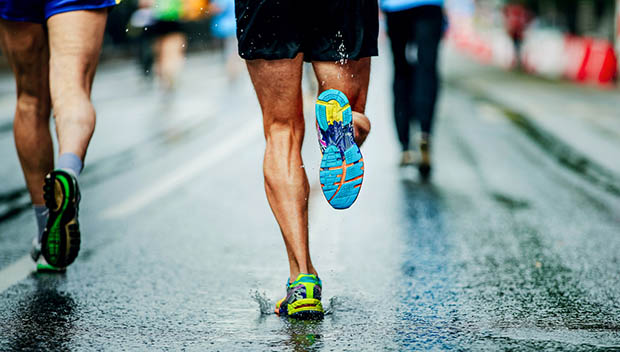
All runners are guilty of skipping a workout when the weather is less than ideal. From humidity that drenches you in sweat the moment you step outside to cold air that causes your fingers and toes to go numb, we are all familiar with weather that makes us want to step back inside. As uncomfortable as it may look, the best thing you can do for your training is run in those adverse conditions.
Training and Racing in Hot, Humid Weather
If you've ever lived in Texas—or anywhere in the south for that matter—you've accepted that you are always sweaty and hot. Even at 6 a.m. you can't take more than five steps without feeling like you just got out of the shower.
Wear the right gear: This is not the time to pull out that cotton shirt from your company's field day. Wear light-colored, loose-fitting technical clothes. Also, there is no such thing as too much body glide; if you want to have a comfortable run, be sure to put it in places you never thought of before. Lastly, wear sunscreen on exposed skin since sunburn inhibits the body's ability to sweat.
Hydrate early and often: Water is always best, but when it is hot and sticky outside, don't forget to take in electrolytes as well. Either bring along salt tabs or have Gatorade on your route.
Accept a Slower Pace: You are going to run slower. In fact, you should be running about one to two minutes slower and pacing by perceived effort not by the time on your watch. Use this calculator to see how the heat will affect your pace.
Plan a route: Plan a route that is mostly in the shade with several water stops along the way. It is a good time to try out trail running to avoid the hot asphalt.
Training and Racing in Cold, Rainy Weather
worst in its history in terms of weather. Temperatures dropped below 40 degrees Celsius with gusting wind and unrelenting rain. I was lucky enough to be one of the runners that prepared for these conditions.
Prepare to get wet: You will get wet. No matter how many trash bags or how much duct tape you use, the water will get in. To keep the rain and cold at bay, use a large black construction bag and poke a few holes for your head and arms. For the race, bring two pairs of running shoes. One pair will be a throwaway, and the other pair are for the race. Nothing feels worse than starting a race with soggy, heavy shoes.
Keep your layers light: When clothes get wet, they absorb water, so wearing several long sleeve layers might work against you. Despite how cold it might be, once you get going, you will warm up. If you are worried about the cold, put Vaseline on the front of your legs, arms and cheeks. Vaseline seals the skin, making it harder for the cold to get to you but also makes it harder to sweat; don't apply too much.
Wear a hat and kitchen gloves: Running in cold, rainy weather means it is time to break out the kitchen gloves! Yes, those big yellow gloves are waterproof and fit right over cozy, cotton mittens. Use a hair tie to tighten them around the wrist. Wearing a hat or visor can keep the rain out of your eyes and hold down your poncho hoodie.
Training and Racing in Snowy, Windy Weather
Running in this kind of weather can not only be challenging but sometimes dangerous. It all comes down to the right gear and mindset.
Wear the right gear: You want your clothes to be tight and your shoes to have traction. Dress in compression layers that you can roll back if you start to overheat. There are three places on your body you need to keep warm: your feet, your hands and your ears. If it is really cold, slip some hand warmers into you gloves. Lastly, protect your face with Vaseline to avoid windburn.
Run by effort, not pace: A headwind can distort your perception of your pace. You are giving it your all, but you are running a minute slower. It is okay to run slower, especially if mother nature is pushing against you. Also, be cautious; treat running in the snow like running on a trail. It is technical and engages other muscles than you might normally use out on clear, dry pavement.
Don't forget to drink and eat: It is easy to forget to fuel when you are not overheated, but you are still expending energy and need to eat and drink. When it comes to fuel, keep gels close to your body so they don't get hardened by the cold. It might be best to carry water with you during the winter as most public water fountains get shut down to prevent the pipes from freezing.
 READ THIS NEXT: 7 Tips for Running in the Rain
READ THIS NEXT: 7 Tips for Running in the Rain


